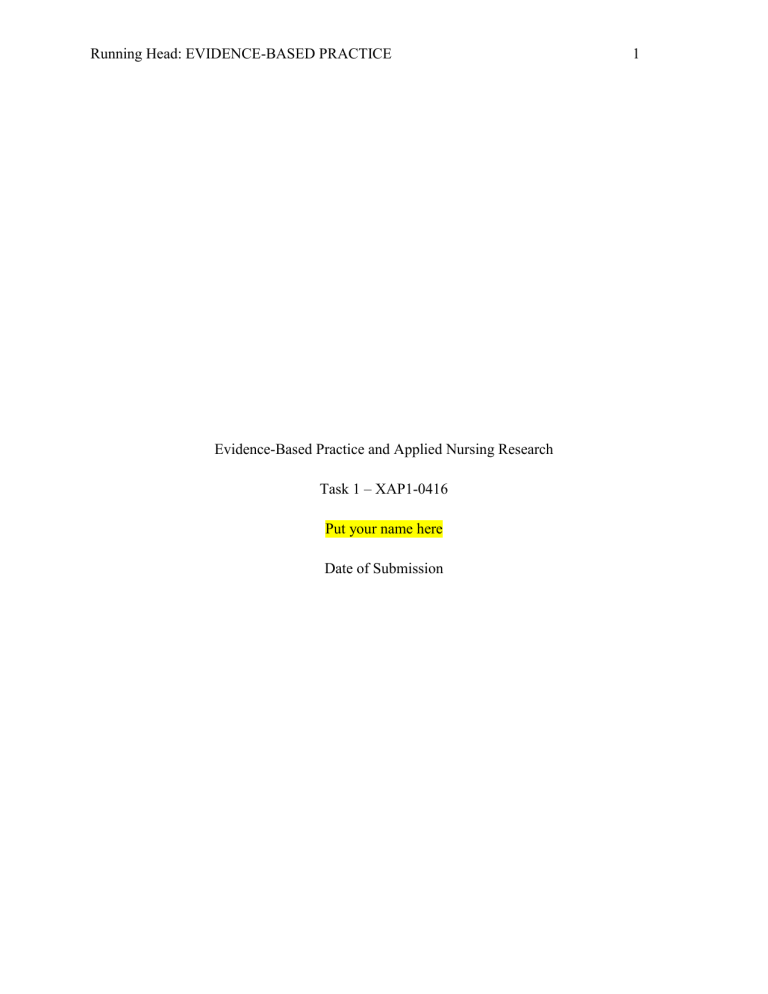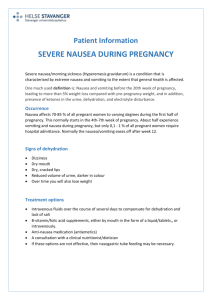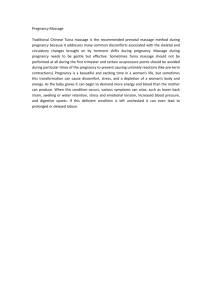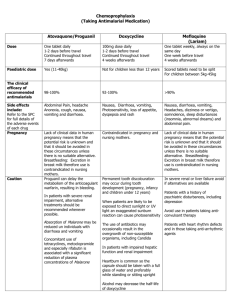
Running Head: EVIDENCE-BASED PRACTICE Evidence-Based Practice and Applied Nursing Research Task 1 – XAP1-0416 Put your name here Date of Submission 1 EVIDENCE-BASED PRACTICE 2 Quantitative Article Joulaeerad, N., Ozgoli, G., Hajimehdipoor, H., Ghasemi, E., & Salehimoghaddam, F. (2018). Effect of Aromatherapy with Peppermint Oil on the Severity of Nausea and Vomiting in Pregnancy: A Single-blind, Randomized, Placebo-controlled trial. Journal of reproduction & infertility, 19(1), 32. Background or Introduction The purpose of this quantitative study was to investigate whether the use of peppermint oil in aromatherapy has any effect on the degree of nausea and vomiting experienced by married women. Aromatherapy can be defined as an alternative treatment method wherein patients are made to inhale special aromatic oils like peppermint oil to harness its therapeutic effect. Nausea and vomiting are usually experienced by pregnant women within their second trimester. Review of the Literature A literature review section Is absent in the journal. However, the author discussed past publications in the introduction section wherein about 21 publications were cited. The author cited some important topics of past publications which serve as evidence of the problem and the first group were topics that discussed clinical features and evaluation of nausea and vomiting of pregnancy (Refuerzo et al., 2015; Herrel,2014; Lee, & Saha, 2011; Niebyl et al., 2010). These studies provided a statement of the NVP problem and were supported by quantifying the global rates of nausea and vomiting of pregnancy. A Meta-analysis described the number of people affected by the problem globally (Einarson et al., 2012). The next group of literature looked at the application of CAM and aromatherapy by midwives on pregnant women to remedy nausea EVIDENCE-BASED PRACTICE 3 and vomiting in pregnancy (Hollyer et al., 2002; Abedzadeh, 2014; Lawless, 2013; Mills et al., 2005), and a pilot study described its effects in early pregnancy (Ghani, & Ibrahim, 2013) Data Analysis In the data analysis section of the study, the mean difference of scores that quantified or numerically represents the severity of NVP in the two study groups was obtained with descriptive statistics of the mean, and was analyzed with inferential statistics using Mann Whitney test, and Analysis of Variance (ANOVA) using SPSS software version 22. The test result for each group was found to be P>0.001 and Test result between the two groups were found to be P=0.227 considered not statistically significant (Joulaeerad et al., 2018). Also, the normality of quantitative data was evaluated using the Kolmogorov-Smirnov test Though Discussion of Methodology The researchers in this study set up a single-blind, randomized, placebo-controlled trial to test the effects of aromatherapy with peppermint oil on the severity of NVP while measuring the effect of placebo or fake treatment for reference purposes. The scientific design employed for the trial is as follows: the researchers decided via a random sampling which of the pregnant women in the trial that will receive the aromatherapy with peppermint oil and which (the control group) that will receive the placebo. A group of 56 pregnant women with mild to moderate severity of NVP and 6-20 weeks old pregnancy had their gestational age and health of fetus determined by means of ultrasound sonography and noting down the last day of menstruation and was recorded while their severity of NVP was recorded by means of the Pregnancy Unique-Quantification of Emesis/Nausea Questionnaire. This was followed by dividing the women into two groups by randomly assigning EVIDENCE-BASED PRACTICE 4 one into each group of peppermint oil (n=28) or placebo (n=28). Randomization was carried out by means of permuted block randomization method to ensure the elimination of bias and this served as one of the strengths of the study. Researcher’s Conclusion The introduction supports the author's conclusion that pregnant women do experience nausea and vomiting starting from the second half of their period of gestation and this condition brings about adverse effects to the health and quality of life of the women. It also supports the conclusion that breathing methods using peppermint oil in aromatherapy and mind-body relaxation techniques can help reduce the severity of NVP experienced by women and improve health and quality of life and as a result, should be encouraged in prenatal training programs. Additional studies are required to test the safety of the aromatherapy procedures to the developing fetus and the mother. The literature review section supports the existence of the problem and is inadequate to support the author’s conclusion that there is a reducing trend on the severity of NVP which was achieved in the study because of how the parameters such as sample size, duration of therapy, time of inhalation, and method of inhalation were narrowed and psychological effects o procedure on subjects. As a result, more precise findings can be achieved by carrying out further studies with a longer period of therapy and incorporating a larger sample size The methods were appropriate to find the result of a decrease in the severity of NVP, and also support the statistically negligible difference in the comparison of the reduction of the severity of NVP in the test and the control group since the study was a single-blind, randomized, placebo-controlled trial where a group of 56 pregnant women with mild to moderate severity of EVIDENCE-BASED PRACTICE 5 NVP and 6-20 weeks old pregnancy were divided into two groups by randomly assigning one into each group of peppermint oil (n=28) or placebo (n=28) hence the two P values that were obtained and compared for significance. What this implies for future research is that this same methodology should be incorporated in order to produce reliable and accurate results. The data analyses used in this study were Mann-Whitney test and ANOVA with repeated measures using SPSS software version 22 where the level of significance was p<0.05 supported the author's finding that the comparison of the effect of aromatherapy with peppermint oil on the severity of NVP on the test group and the placebo group produce a difference which is considered statistically insignificant in this study and as a result, the null hypothesis was rejected. Further studies on this issue should use the tests of significance applied in this study because they are parametric tests and hence produce reliable results. Ethical Considerations This journal has no section for Ethical Consideration and the author stated nothing as regards to informed consent and Institutional Review Board approval. Efforts were made to protect the human subjects in this study, using the exclusion criteria. Participants with NVP score of more than 13 on the PUQE questionnaire indicating a higher severity of nausea and vomiting and were excluded from this study. This is because it would be hazardous to such category of the human subjects if they should be sacrificing the standard care of their condition for the sake of a dummy treatment. In addition, other subjects who are sensitive to peppermint or intolerant of peppermint aroma were also excluded. Phone numbers were made available for the participants to call in whenever they have any issues of concern throughout the study period. No cultural considerations were made on the study as participants were all Iranian. The researcher did not EVIDENCE-BASED PRACTICE indicate writing to the institutional review board prior to the study and this step is important to ensure strict adherence to the ethical values underlying the study and to assure the public that the conduct of the research was according to ethical standards. The researchers did not indicate any measure(s) taken to address issues of informed consent, privacy, and confidentiality in the data collection process and the method of storing the PUQE data and other data collection inventories with subjects’ information are unknown. Strength and Limitation of the Study Strength The study rated the severity of NVP with PUQE questionnaire which is a reliable and standard tool for assessing these symptoms. Also, the use of permuted block randomization method in sampling ensured that the study is free from selection bias. Limitation One of the identifiable weaknesses in this study is the difference in the psychological status of pregnant women which took part in this study as at the study period which triggered individually different psychological reactions to the aroma during the test. Clinical Application of Evidence The findings of this study suggest that while there is a reduction in the severity of NVP in each intervention group as evidenced in the PUQE recordings, this decrease was not statistically significant with the effect of aromatherapy on the Test group similar to that of the Control group. This similarity implies that Aromatherapy with Peppermint Oil is not able to reduce the Severity of Nausea and Vomiting in Pregnancy and as a result should never be used as the first line of treatment in NVP until future studies prove otherwise with statistically significant results and also evaluates the safety of use to both mother and fetus. However, women should be encouraged 6 EVIDENCE-BASED PRACTICE 7 to practice mental relaxation techniques like breathing methods during pregnancy so as to reduce the severity of NVP may be reduced. Qualitative Article Ho, S. S., Kwong, A. N., Wan, K. W., Ho, R. M., & Chow, K. M. (2017). Experiences of aromatherapy massage among adult female cancer patients: A qualitative study. Journal of clinical nursing, 26(23-24), 4519-4526. https://doi.org/10.1111/jocn.13784 Background or Introduction The purpose of this study was to investigate how female cancer patients felt when using aromatherapy massage to manage their health condition. To also find out if there were any side effects of using aromatherapy massage among female cancer patients aged 21 and above. The focus of this study which is aromatherapy massage is defined as a treatment regimen that employs essential oils like peppermint oil obtained from plants on the body surface to harness the curative properties. Review of the Literature A literature review section s absent in the journal. However, the author discussed past publications in the introduction section wherein about 17 publications were cited and reviewed. The author cited some topics of past publications which serve as evidence of the problem and the topics includes studies that discussed the application of CAM and aromatherapy in the treatment of cancer and in palliative care among Chinese female cancer population which is the focus of this study (Harris, Finlay, Cook, Thomas, & Hood, 2003; Molassiotis et al., 2005; Scott, Kearney, Hummerston, & Molassiotis, 2005; Kristoffersen, Norheim, & Fønnebø, 2013; EVIDENCE-BASED PRACTICE 8 Verhoef, Balneaves, Boon, & Vroegindewey, 2005; Boehm et al., 2012; Fellowes, Barnes, & Wilkinson, 2004). Another group of literature reviewed in the study discussed quantitatively the efficiency of ATM and CAM in the treatment of certain symptoms of discomfort and health disorders frequently occurring in cancer patients (Boehm et al., 2012; Lai et al., 2011; Serfaty, Wilkinson, Freeman, Mannix, & King, 2012; Soden, Vincent, Craske, Lucas, & Ashley, 2004; Stringer, Swindell, & Dennis, 2008; Wilkinson, Aldridge, Salmon, Cain, & Wilson, 1999). The last group of studies reviewed in this study discussed qualitatively how the study participants (both male and female) felt when they were subjected to cancer treatment using ATM (Dunwoody, Smyth, & Davidson, 2002) or mostly male gender (Hadfield, 2001). Data Analysis The researcher transcribed the audio interview verbatim and employed the principle of content analysis in the analysis of the data. The data collected was translated from Chinese to English and the researcher examined and interpreted the raw textual data line by line to identify discrete events, incidents, ideas, actions, perceptions, and interactions of relevance. The data was then coded based on a categorization scheme as concepts whereby each concept is linked to specific portions of the text (coding unit). Methodology The researcher set up a descriptive, exploratory and qualitative in-depth semi-structured interview for this study. Eligible participants for this study were female cancer patients over the age of 21 who could communicate in Cantonese at a fluent level, had managed their condition with ATM and also gave consent to participate. They were gotten by means of enrolment from cancer self-help groups and referrals of a private aromatherapy clinic by means convenience sampling. EVIDENCE-BASED PRACTICE 9 The researcher collected data for this study by means of fifteen semi-structured interviews on the use of ATM conducted in a private room using an interview guide with the process lasting for 45–60 min for each participant. The sample size was determined based on the guiding principle of data saturation which refers to the quality and quantity of information that can be found in a qualitative study. Researcher’s Conclusion The introduction supports the author's conclusion that aromatherapy massage, a CAM approach is effective in providing relief or the symptoms of cancer because of the holistic and specificity approach of the procedure. This is true owing to the response gathered from the participants who all expressed satisfaction with the procedure and were very pleased with how the treatment enhances their dignity and its lack of side effects. Future studies in this subject are required to measure the dignity enhancing effects of ATM cancer treatment procedure in Chinese female patients. This is in line with the perceived distorted body image which female cancer patients were reported to be having once they have come under the knife and lost a body part. The literature review section supports the author’s conclusion that ATM offered a positive approach which encouraged women with breast cancer to do away with the distorted body image perception they were reported having after the surgery and accept their loss. This was in confirmation with previous studies which discussed how massage offered a platform or avenue of holistic and individualized care delivery in breast cancer patients which they reported to be an awesome and welcoming experience. Data or this study was collected by means of convenience sampling a type of nonprobability sampling method where the sample is taken from a group of people on the basis of their availability and ease of reach. This method is appropriate to generalize that the study EVIDENCE-BASED PRACTICE provided a better understanding of ATM on Chinese female cancer patients’ because this study used a qualitative approach and documented live experiences of cancer patients who received ATM and as a result, added to the body of knowledge on the subject matter. This study cannot be used to generalize for a greater population because of selection bias which resulted from the nonprobability sampling method used. Additional studies on the administration of ATM on cancer patient should endeavor to employ randomization and probability in sampling to produce a result that can give insights on what is expected from a larger population. The data analyses supported the author's finding that supports the outcome of the study that CAM approach is effective in providing relief or the symptoms of cancer because the data analysis approach applied here involved counting and comparison of keywords or content, followed by the interpretation of the underlying context using a categorization scheme which helped ensure the delineation of analytic procedures specific to the data and techniques addressing trustworthiness in terms of consistency, accuracy, objectivity, and credibility. To ensure consistency and accuracy, the analytic procedures and findings were documented as fully and truthfully as possible so that any further studies carried out in the future with a similar context could be used for regenerating themes Protection and Considerations The researcher obtained approval on ethical grounds from the University’s Clinical Research Ethics Committee. Issues of privacy and confidentiality of health records obtained from the subjects were addressed as well as anonymity o subject participants as the data collection sheet can be seen to bear no names. Storage and handling of subject’s data were performed electronically which only researchers could access further ensuring intrusion-proof. Issue of informed consent was also addressed as the participants were briefed on the nature of the 10 EVIDENCE-BASED PRACTICE 11 study and what it intends to achieve prior to kickoff. It is expected that one criterion for exclusion in a study such as this should be based on the severity of the patient's cancer condition. This is such that patients with a more severe condition up to a certain level of disease progression will be excluded from the study to enable them to concentrate on other evidencebased treatment practices. This method of exclusion which protects the health of human subjects was not applied. Strength and Limitation of the Study Strength Data for the study was collected by means of an interview consisting of open-ended questions asking the subjects to describe how they felt when having aromatherapy massage (Ho et al., 2017). The audio interview was transcribed verbatim, translated from English to Chinese and the principle of content analysis in the analysis of the data. Limitation Evidence from the method of sampling used in this study does not support the outcome of the study because of the possibility of sampling error and lack of representation of the population. Hence it cannot be used to draw inference on a larger group. Evidence Application Findings from this study explained the benefits of aromatherapy massage a form of alternative medicine, and also the factors on which these benefits may depend on. The study also hinted on how important the act of "touch" in gender-specific cancer-care delivery. Investigating the live experience of ATM and its implications in a clinical setting provide the health-care professional care insights into the actual holistic needs and preferences of the female cancer population. Nurses are therefore encouraged to learn from this study and widen their scope of EVIDENCE-BASED PRACTICE practice to incorporate knowledge and skills of aromatherapy massage through the acquisition an understanding of specific essential oils pharmacology, massage skills and therapeutic efficacy for the management of symptoms in cancer care. 12 EVIDENCE-BASED PRACTICE 13 References Abedzadeh Kalahroudi M. Complementary and alternative medicine in midwifery. Nurs Midwifery Stud. 2014;3(2):e19449. Badell ML, Ramin SM, Smith JA. Treatment options for nausea and vomiting during pregnancy. Pharmacotherapy. 2006;26:1273-87. Boehm, K., Bussing, A., & Ostermann, T. (2012). Aromatherapy as an adjuvant treatment in cancer care: A descriptive systematic review. African Journal of Traditional, Complementary, and Alternative Medicines, 9, 503–518. Einarson T, Piwko C, Koren G. Quantifying the global rates of nausea and vomiting of pregnancy: a meta-analysis. J Popul Ther Clin Pharmacol. 2012; 20(2):171-83. Fellowes, D., Barnes, K., & Wilkinson, S. (2004). Aromatherapy and massage for symptom relief in patients with cancer. Cochrane Database of Systematic Reviews, 4, Art. No.: CD002287. Five Ghani RMA, Ibrahim ATA. The effect of aromatherapy inhalation on nausea and vomiting in early pregnancy: a pilot randomized controlled trial. JNat Sci Res. 2013;3(6):192-205. Harris, P., Finlay, I. G., Cook, A., Thomas, K. J., & Hood, K. (2003). Complementary and alternative medicine use by patients with cancer in Wales: A cross-sectional survey. Complementary Therapies in Medicine, 11, 249–253. Herrell HE. Nausea and vomiting of pregnancy. Am Fam Physician. 2014;89(12):965-70. Hollyer T, Boon H, Georgousis A, Smith M, Einarson A, et al. The use of CAM by women suffering from nausea and vomiting during pregnancy. BMC Complement Altern Med. 2002;2:5. EVIDENCE-BASED PRACTICE Kristoffersen, A. E., Norheim, A. J., & Fønnebø, V. M. (2013). Complementary and alternative medicine use among Norwegian cancer survivors: Gender-specific prevalence and associations for use. evidence-based Complementary and Alternative Medicine, 16, 655– 663. Lai, T. K., Cheung, M. C., Lo, C. K., Ng, K. L., Fung, Y. H., Tong, M., & Yau, C. C. (2011). Effectiveness of aroma massage on advanced cancer patients with constipation: A pilot study. Complementary Therapies in Clinical Practice, 17, 37–43. Lawless J. The encyclopedia of essential oils: the complete guide to the use of aromatic oils in aromatherapy, herbalism, health and well being. 1st ed. San Francisco: Red Wheel Weiser; 2013. 224 p.16. Lee NM, Saha S. Nausea and vomiting of pregnancy. Gastroenterol Clin North Am. 2011;40(2):309- 34. Mills SY, Bone K, Mills S, Bone K. The essential guide to herbal safety. 1st ed. The United States of America: Elsevier Churchill Livingstone; 2005. 704 p. Molassiotis, A., Fernadez-Ortega, P., Pud, D., Ozden, G., Scott, J. A., Panteli, V Patiraki, E. (2005). Use of complementary and alternative medicine in cancer patients: A European survey. Annals of Oncology, 16, 655–663. Niebyl JR. Clinical practice. Nausea and vomiting in pregnancy. N Eng J Med. 2010;363(16):1544-50. If Refuerzo JS, Smith JA, Ramin SM. Clinical features and evaluation of nausea and vomiting of pregnancy [Internet]. Waltham, MA: UpToDate Inc; 2015April 25 [cited 2017 Jun 3]. 14 EVIDENCE-BASED PRACTICE Available from: https:// www.uptodate.com/contents/clinical-features-andevaluation-ofnausea-and-vomiting-of-pregnancy Scott, J. A., Kearney, N., Hummerston, S., & Molassiotis, A. (2005). Use of complementary and alternative medicine in patients with cancer: A UK survey. European Journal of Oncology Nursing, 9, 131–137. Serfaty, M., Wilkinson, S., Freeman, C., Mannix, K., & King, M. (2012). The ToT study helping with Touch or Talk (ToT): A pilot randomized controlled trial to examine the clinical effectiveness of aromatherapy massage versus cognitive behavior therapy for emotional distress in patients in cancer/palliative care. Psychooncology, 21, 563–569. Soden, K., Vincent, K., Craske, S., Lucas, C., & Ashley, S. (2004). A randomized controlled trial of aromatherapy massage in a hospice setting. Palliative Medicine, 18, 87–92. Stringer, J., Swindell, R., & Dennis, M. (2008). Massage in patients undergoing intensive chemotherapy reduces serum cortisol and prolactin. Psycho-Oncology, 17, 1024–1031. Verhoef, M. J., Balneaves, L. G., Boon, H. S., & Vroegindewey, A. (2005). Reasons for and characteristics associated with complementary and alternative medicine use among adult cancer patients: A systematic review. Integrative Cancer Therapies, 4, 274–286. Wilkinson, S., Aldridge, J., Salmon, I., Cain, E., & Wilson, B. (1999). Evaluation of aromatherapy massage in palliative care. Palliative Medicine, 13(5), 409–417. 15

![Questionnaire used in the study Demographics GENDER: M [ ] F](http://s3.studylib.net/store/data/006712173_1-21c851410b04058d524e1b79e54e32b0-300x300.png)



